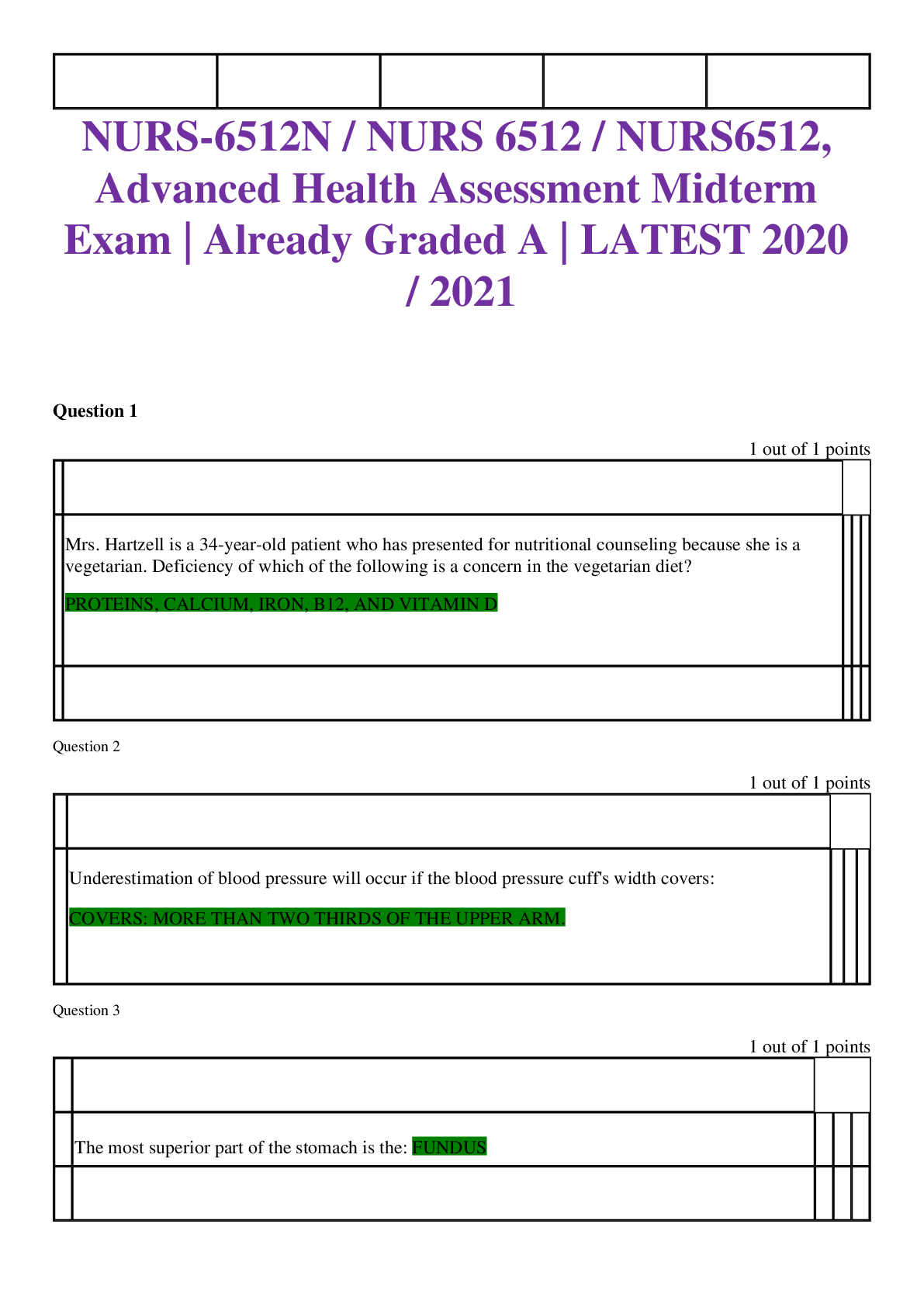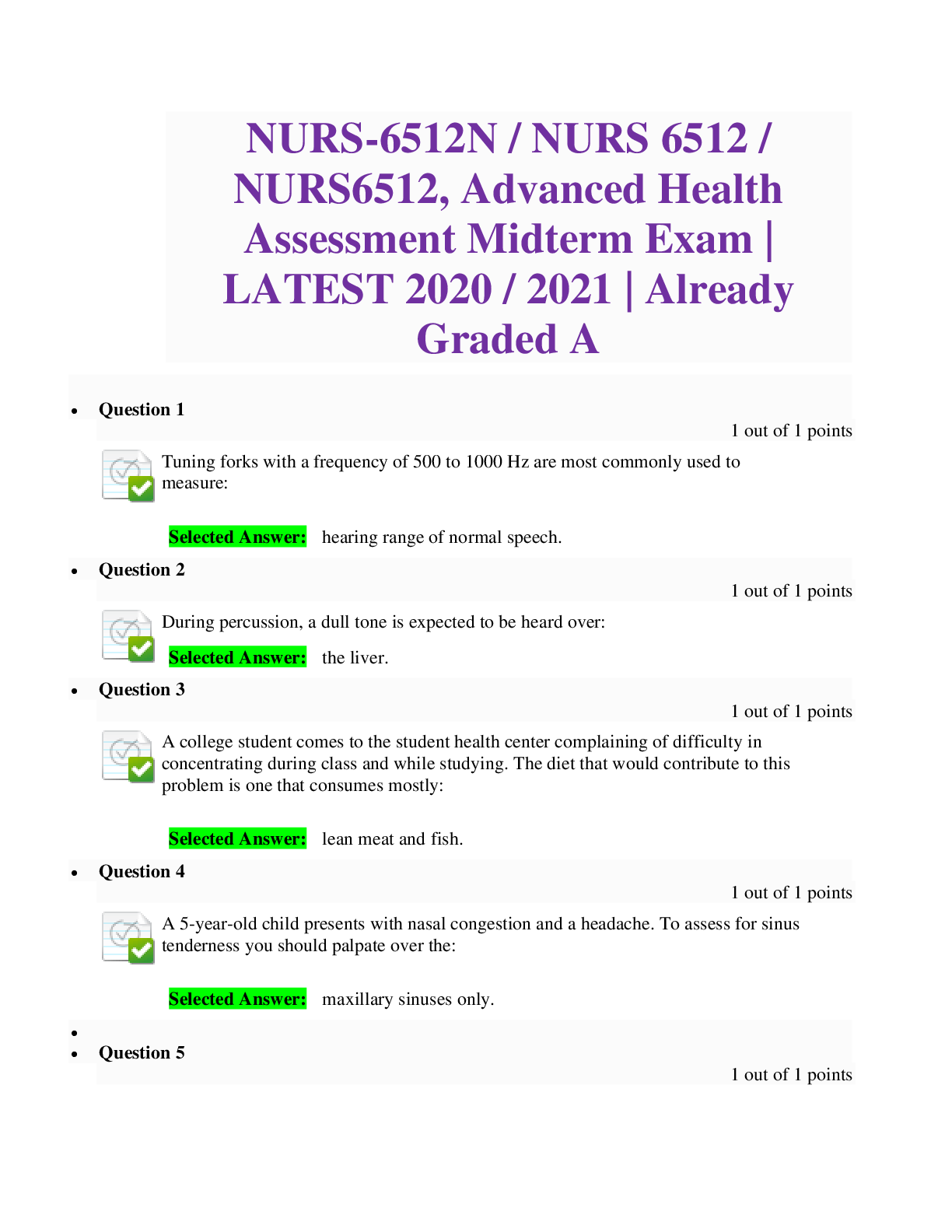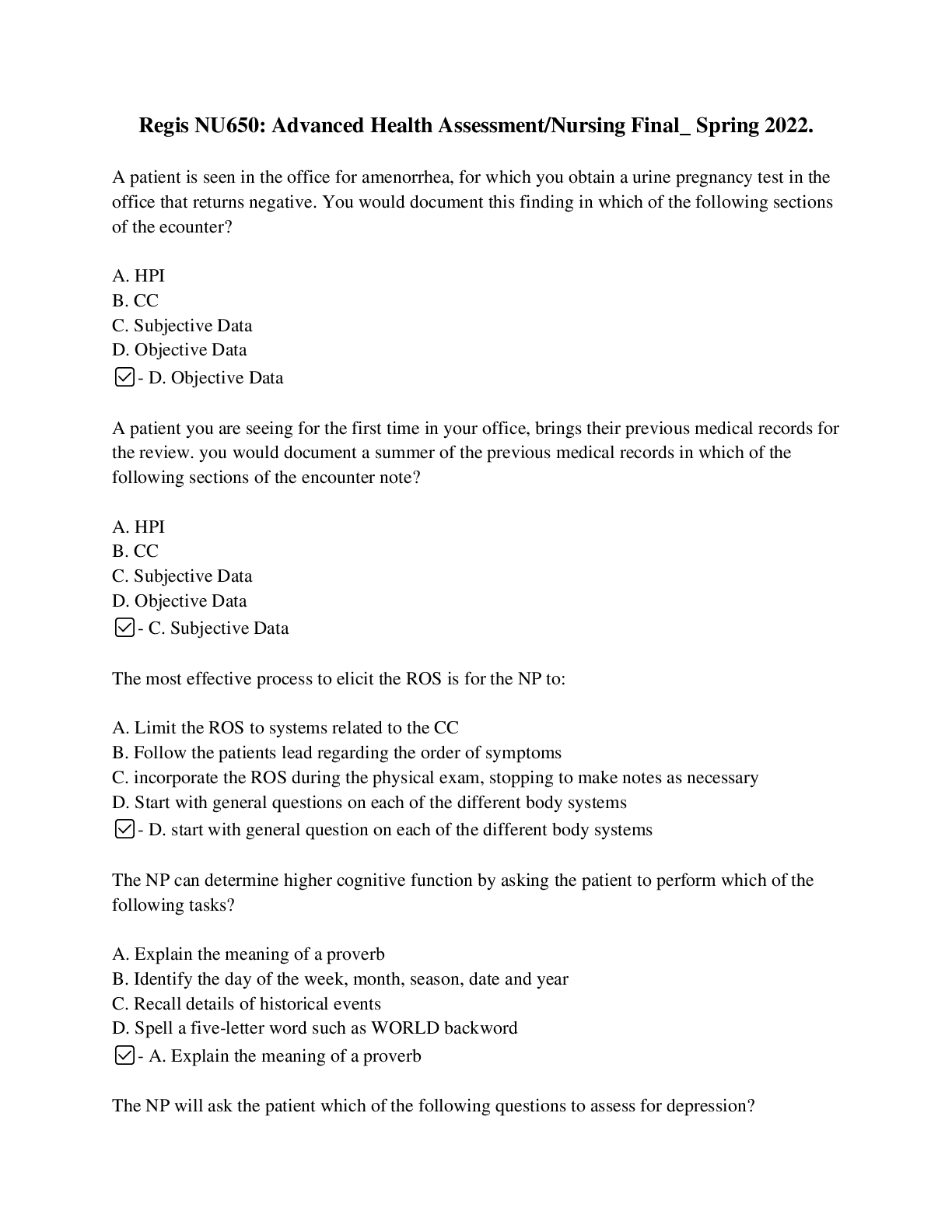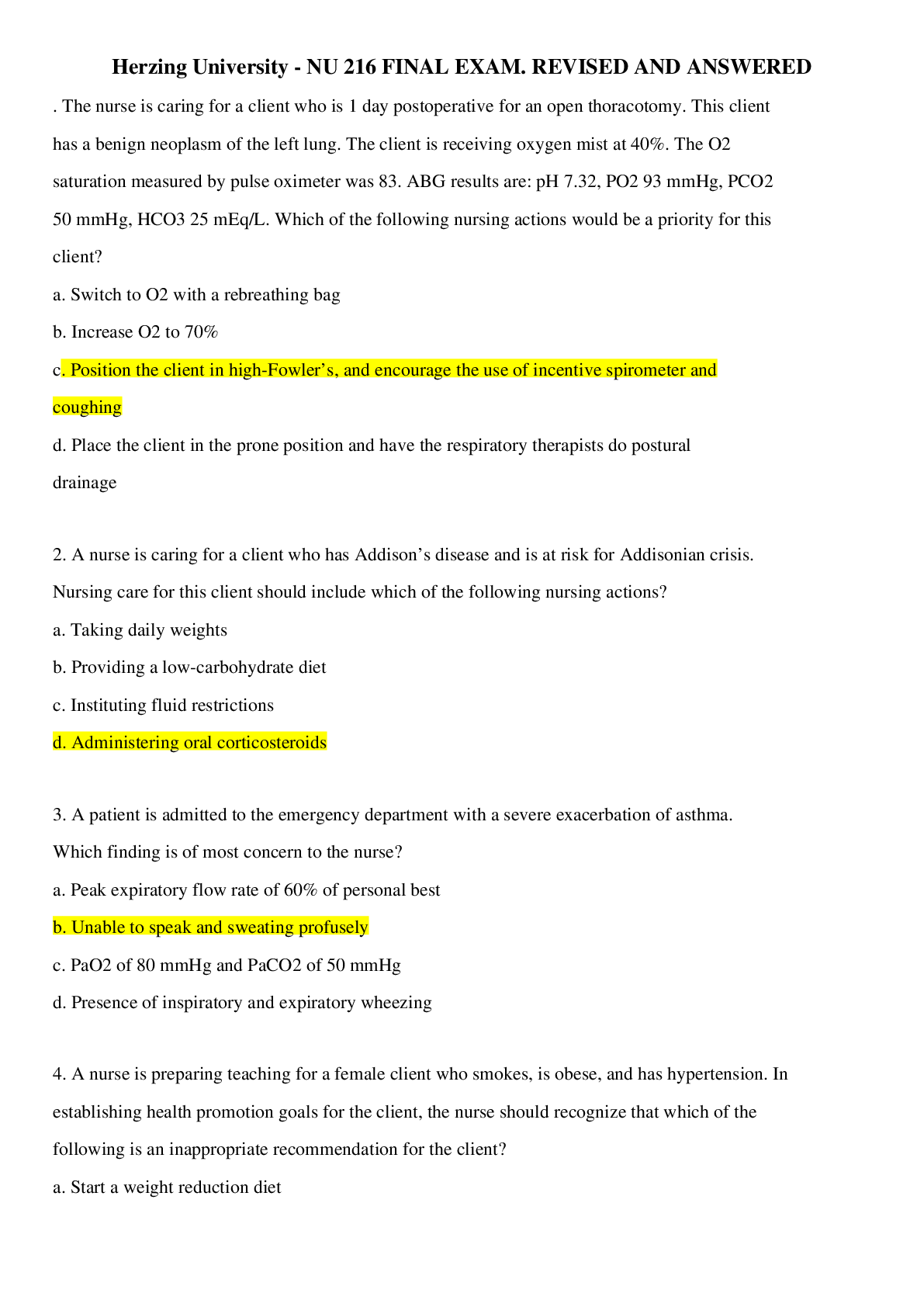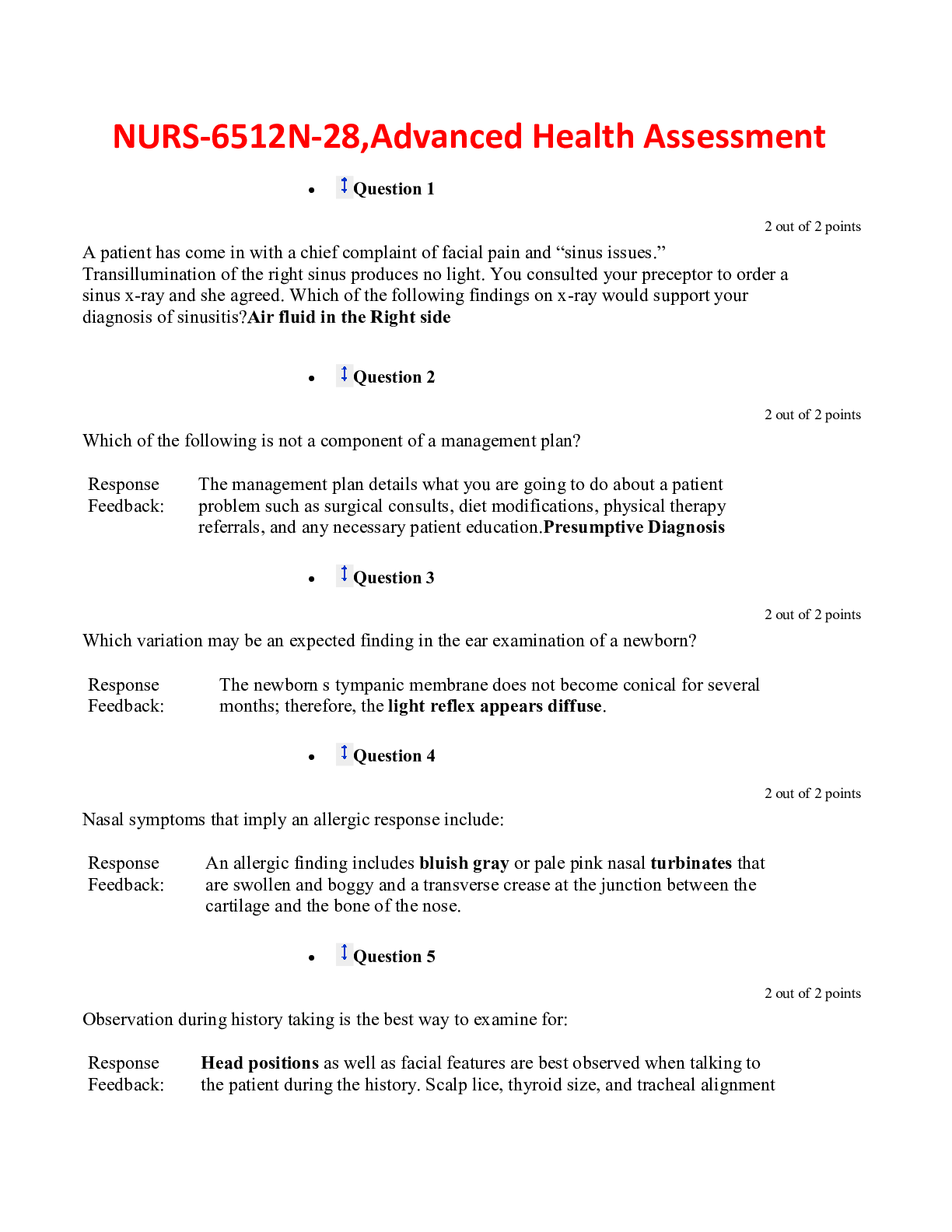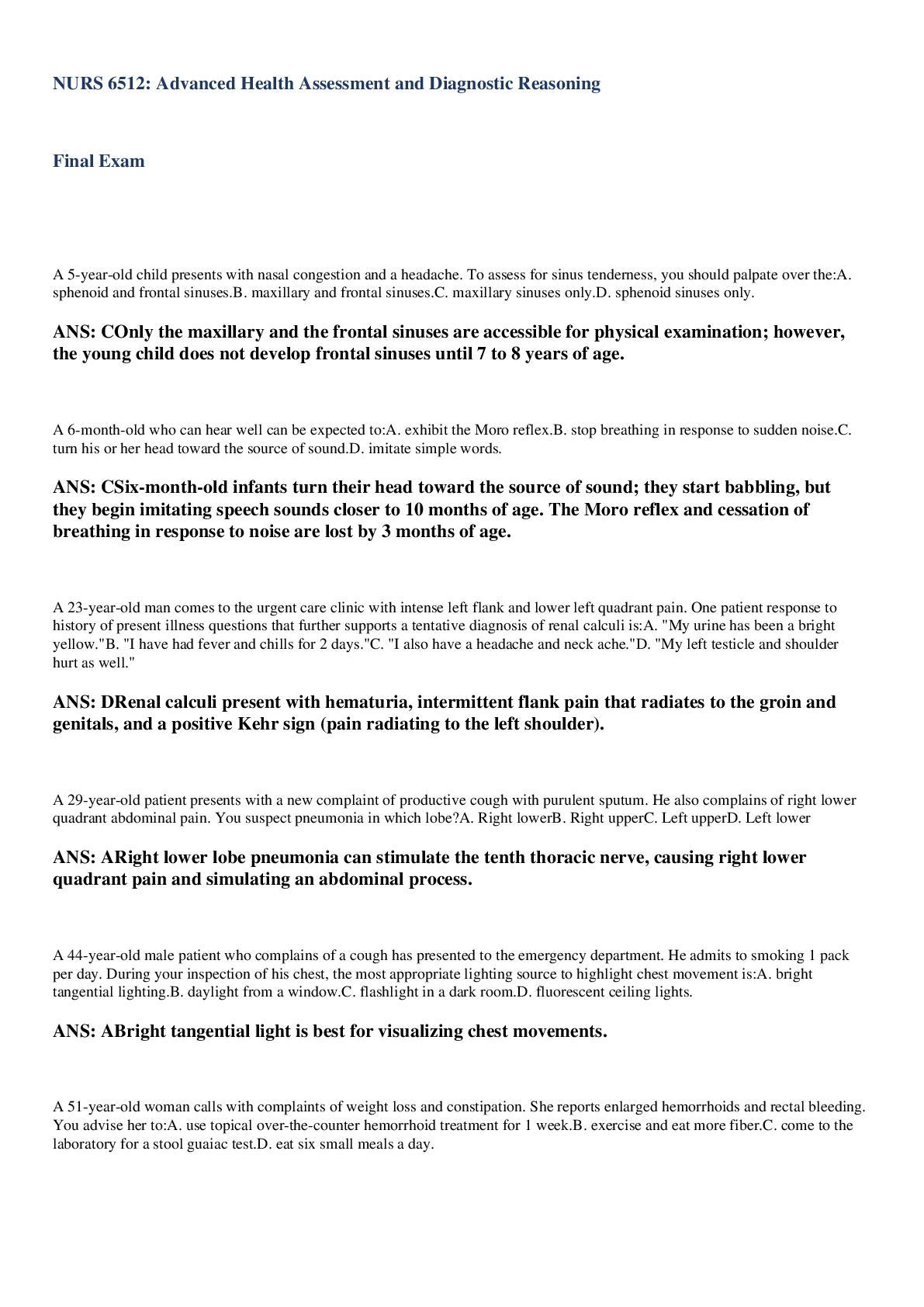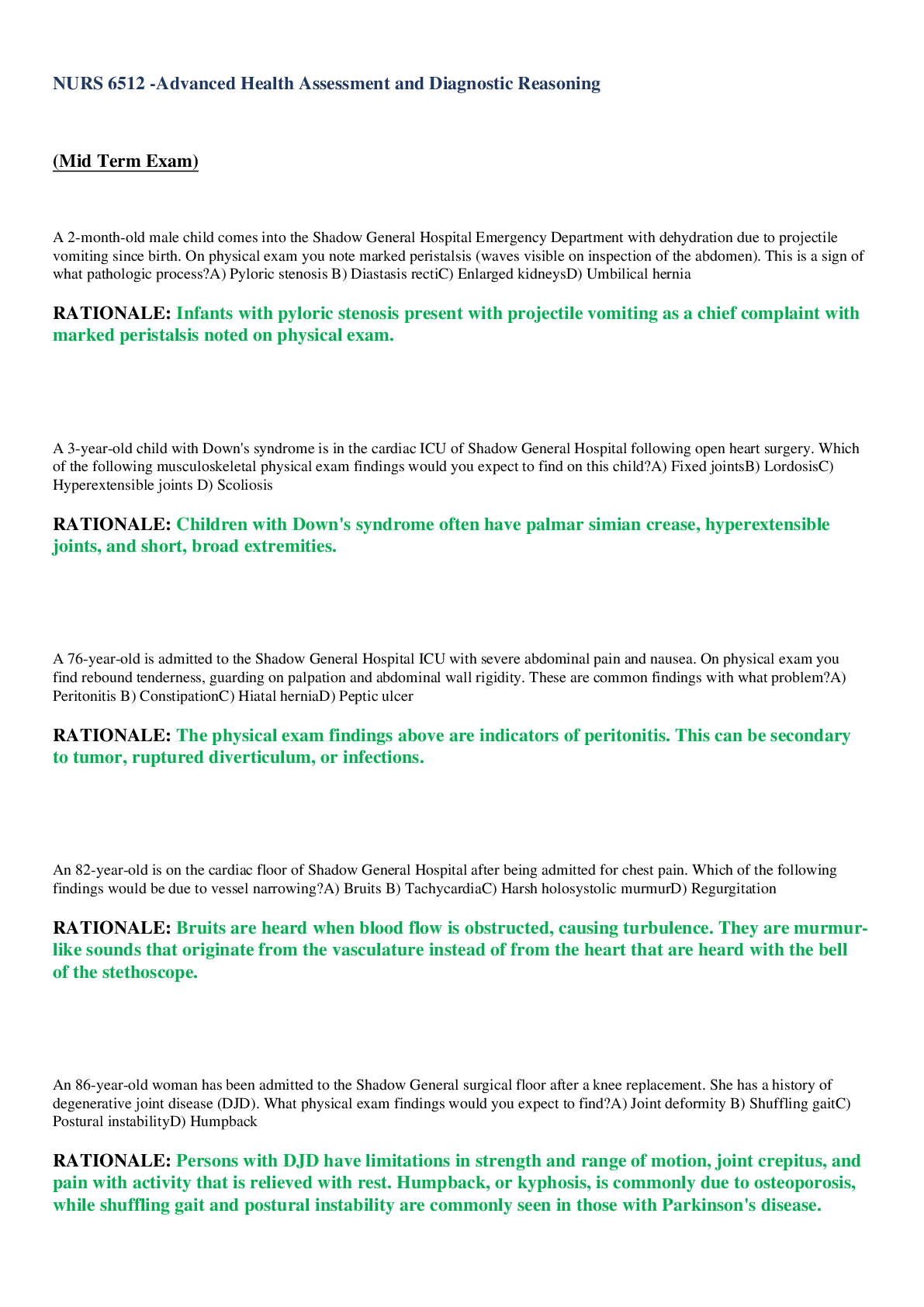*NURSING > EXAM > NUR 634 Advanced Health Assessment and Diagnostic Reasoning With Skills Lab - Final Exam Test Prep L (All)
NUR 634 Advanced Health Assessment and Diagnostic Reasoning With Skills Lab - Final Exam Test Prep Latest 2019/2020, A Work.
Document Content and Description Below
Grand Canyon University - NUR 634 : Final Exam Test Prep Latest 2019/2020. NUR 634 Final Exam 1. Question: You are examining an elderly man and notice the following: Decreased vibration sense in the f... eet and ankles, diminished gag reflex, right patellar reflex less than the left, and diminished abdominal reflexes. Which of these is abnormal? 2. Question:A 68-year-old retired farmer presents to your office for evaluation of a skin lesion. On the right temporal area of the forehead, you see a flattened papule the same color as his skin, covered by a dry scale that is round and feels hard. He has several more of these scattered on the forehead, arms, and legs. Based on this description, what is your most likely diagnosis? 3. Question: A 14-year-old junior high school student is brought in by his mother and father because he seems to be developing breasts. The mother is upset because she read on the Internet that smoking marijuana leads to breast enlargement in males. The young man adamantly denies using any tobacco, alcohol, or drugs. He has recently noticed changes in his penis, testicles, and pubic hair pattern. Otherwise, his past medical history is unremarkable. His parents are both in good health. He has two older brothers who never had this problem. On examination, you see a mildly overweight teenager with enlarged breast tissue that is slightly tender on both sides. Otherwise his examination is normal. He is agreeable to taking a drug test. What is the most likely cause of his gynecomastia? 4. Question: A 17-year-old female presents to your office, complaining of a clear discharge from her right breast for 2 months. She states that she noticed it when she and her boyfriend were “messing around” and he squeezed her nipple. She continues to have this discharge anytime she squeezes that nipple. She denies any trauma to her breasts. Her past medical history is unremarkable. She denies any pregnancies. Both of her parents are healthy. She denies using tobacco or illegal drugs and drinks three to four beers a week. On examination, her breasts are symmetric with no skin changes. You are able to express clear discharge from her right nipple. You feel no discrete masses and her axillae are normal. The remainder of her heart, lung, abdominal, and pelvic examinations are unremarkable. A urine pregnancy test is negative. What cause of nipple discharge is the most likely in her circumstance? 5. Question:A 26-year-old flight attendant presents in for a third trimester prenatal visit. She has had prenatal care since her sixth week of pregnancy. She has no complaints today and her prenatal course has been unremarkable. Today her blood pressure and weight gain are appropriate, and her urine is unremarkable. You have a first-year medical student shadowing you, so you ask the student to get Doptones and measure the patient’s uterus in centimeters. The nurse practitioner student promptly reports fetal heart tones of 140, but he is having difficulty obtaining the correct measurement. He knows one end of the tape goes over the uterine fundus. From what inferior anatomic position should the tape be placed? 6. Question: A 58-year-old gardener presents to your office for evaluation of a new lesion on her upper chest. The lesion appears to be “stuck on” and is oval, brown, and slightly elevated with a flat surface. It has a rough, wart like texture on palpation. Based on this description, what is your most likely diagnosis? 7. Question: Which of the following represents age-related changes in the lungs? 8. Question: A 15-month-old is brought to you for a fever of 38.6 degrees Celsius and fussiness. The ear examination is as follows: external ear, normal appearance and no tenderness with manipulation; canal, normal diameter without evidence of inflammation; tympanic membrane, bulging, erythematous, and opaque. Insufflation is deferred due to pain. What is the most likely condition here? 9. Question: A 28-year-old musician presents to your clinic, complaining of a “spot” on his penis. He states his partner noticed it 2 days ago and it hasn’t gone away. He says it doesn’t hurt. He has had no burning with urination and no pain during intercourse. He has had several partners in the last year and uses condoms occasionally. His past medical history consists of nongonococcal urethritis from Chlamydia and prostatitis. He denies any surgeries. He smokes two packs of cigarettes a day, drinks a case of beer a week, and smokes marijuana and occasionally crack. He has injected IV drugs before but not in the last few years. He is single and currently unemployed. His mother has rheumatoid arthritis, and he doesn’t know anything about his father. On examination, you see a young man appearing deconditioned but pleasant. His vital signs are unremarkable. On visualization of his penis, there is a 6-mm red, oval ulcer with an indurated base just proximal to the corona. There is no prepuce because of neonatal circumcision. On palpation, the ulcer is nontender. In the inguinal region, there is nontender lymphadenopathy. What disorder of the penis is most likely the diagnosis? 10. Question: A 22-year-old law student presents to your office complaining of severe abdominal pain radiating to his back. He states it began last night after hours of heavy drinking. He has had abdominal pain and vomiting in the past after drinking but never as bad as this. He cannot keep any food or water down, and these symptoms have been going on for almost 12 hours. He has had no recent illnesses or injuries. His past medical history is unremarkable. He denies smoking or using illegal drugs but admits to drinking 6 to 10 beers per weekend night. He admits that last night he drank something like 14 drinks. On examination you find a young male appearing his stated age in some distress. He is leaning over on the examination table and holding his abdomen with his arms. His blood pressure is 90/60 and his pulse is 120. He is afebrile. His abdominal examination reveals normal bowel sounds, but he is very tender in the left upper quadrant and epigastric area. He has no Murphy’s sign or tenderness in the right lower quadrant. The remainder of his abdominal examination is normal. His rectal, prostate, penile, and testicular examinations are normal. He has no inguinal hernias or tenderness with that examination. Blood work is pending. What etiology of abdominal pain is most likely causing his symptoms? 11. Question: A 56-year-old female presents to your clinic complaining that her left breast looks unusual. She says that for 2 months the angle of the nipple has changed direction. She does not do self-examinations, so she doesn’t know if she has a lump. She has no history of weight loss, weight gain, fever, or night sweats. Her past medical history is significant for high blood pressure. She smokes two packs of cigarettes a day and has three to four drinks per weekend night. Her paternal aunt died of breast cancer in her forties. Her mother is healthy, but her father died of prostate cancer. On examination, you find a middle-aged woman appearing older than her stated age. Inspection of her left breast reveals a flattened nipple deviating toward the lateral side. On palpation, the nipple feels thickened. Lateral to the areola you palpate a nontender 4-cm mass. The axilla contains several fixed nodes. The right breast and axilla examinations are unremarkable. What visible skin change of the breast does she have? 12. Question: A 32-year-old white female presents to your clinic complaining of overwhelming sadness. She says for the past 2 months she has had crying episodes, difficulty sleeping, and problems with overeating. She says she used to go out with her friends from work, but now she just wants to go home and be by herself. She also thinks that her work productivity has been dropping because she just is too tired to care or concentrate. She denies any feelings of guilt or any suicidal ideation. She states that she has never felt this way in the past. She denies any recent illness or injuries. Her past medical history consists of an appendectomy when she was a teenager; otherwise, she has been healthy. She is single and works as a clerk in a medical office. She denies tobacco, alcohol, or illegal drug use. Her mother has high blood pressure and her father has had a history of mental illness. On examination, you see a woman appearing her stated age who seems quite sad. Her facial expression does not change while you talk to her and she makes little eye contact. She speaks so softly you cannot always understand her. Her thought processes and content seem unremarkable. What type of mood disorder do you think is most likely? 13. Question: A young Hispanic mother brings in her 2-month-old son. She is upset because her neighbors have threatened to call the Child Protective Agency because they think his birthmark is a bruise. Her son was the product of an uneventful pregnancy and spontaneous vaginal delivery. On examination, you see a large, smooth-bordered bluish mark on his buttock and lower back. Otherwise his examination is unremarkable. What form of birthmark is this likely to be? 14. Question: A 15-year-old high school sophomore presents to the clinic for evaluation of a 3-week history of sneezing; itchy, watery eyes; clear nasal discharge; ear pain; and nonproductive cough. Which is the most likely pathologic process? 15. Question: A 22-year-old clerk, primigravida, presents to your office for a prenatal visit. She is in her second trimester and has had prenatal care since she was 8 weeks pregnant. Her only complaint is that she has a new brownish line straight down her abdomen. On examination her vital signs are unremarkable. Her urine has no protein, glucose, or leukocytes. With a doppler the fetal heart rate is 140, and her uterus is palpated to the umbilicus. Today you are sending her for congenital abnormality screening and setting up an ultrasound. What physical finding is responsible for her new “brown line”? 16. Question: Q. is a 45-year-old salesman who presents to your office for evaluation of fatigue. He has come to the office many times in the past with a variety of injuries, and you suspect that he has a problem with alcohol. Which one of the following questions will be most helpful in diagnosing this problem? 17. Question: A 35-year-old bus driver presents to your office for a prenatal visit. She is approximately 28 weeks pregnant and has had no complications. She is complaining only of heartburn and has had no fatigue, headaches, leg swelling, contractions, leakage of fluid, or bleeding. On examination, her blood pressure is 142/92 and her urine shows no glucose, protein, or leukocytes. Her weight gain is appropriate, with no large recent increases. Fetal tones are 140 and her uterus measures 32 cm from the pubic bone. Looking back through her chart, you see her prenatal blood pressure was 120/70 and her blood pressures during the first 20 weeks were usually 120 to 130/70 to 80. What type of blood pressure is this? 18. Question: A sudden, painless unilateral vision loss may be caused by which of the following? 19. Question: A 40-year-old mother of two presents to your office for consultation. She is interested in knowing what her relative risks are for developing breast cancer. She is concerned because her sister had unilateral breast cancer 6 years ago at age 38. The patient reports on her history that she began having periods at age 11 and has been fairly regular ever since, except during her two pregnancies. Her first child arrived when she was 26 and her second at age 28. Otherwise, she has had no health problems. Her father has high blood pressure. Her mother had unilateral breast cancer in her 70s. The patient denies tobacco, alcohol, or drug use. She is a family law attorney and is married. Her examination is essentially unremarkable. Which risk factor of her personal and family history most puts her in danger of getting breast cancer? 20. Question: When should a woman conduct breast self-examination with respect to her menses? 21. Question: Jacob, a 33-year-old construction worker, complains of a “lump on his back” over his scapula. It has been there for about a year and is getting larger. He says his wife has been able to squeeze out a cheesy-textured substance on occasion. He worries this may be cancer. When gently pinched from the side, a prominent dimple forms in the middle of the mass. What is most likely? 22. Question: You have been unable to hear normal S2 splitting in children up to this point. What technique will maximize your chances of hearing this phenomenon? 23. Question: A grandmother brings her 13-year-old grandson to you for evaluation. She noticed last week when he took off his shirt that his breastbone seemed collapsed. He seems embarrassed and tells you that it has been that way for quite some time. He states he has no symptoms from it, and he just tries not to take off his shirt in front of anyone. He denies any shortness of breath, chest pain, or lightheadedness on exertion. His past medical history is unremarkable. He is in sixth grade and just moved in with his grandmother after his father was deployed to the Middle East. His mother died several years ago in a car accident. He states that he does not smoke and has never touched alcohol. On examination, you see a teenage boy appearing his stated age. On visual examination, of his chest you see that the lower portion of the sternum is depressed. Auscultation of the lungs and heart are unremarkable. What disorder of the thorax best describes your findings? 24. Question: Ray works a physical job and notes pain when he attempts to lift his arm over his head. When you move the shoulder passively, he has full range of motion without pain and there is no gross swelling or tenderness. What type of joint disease does this most likely represent? 25. Question: Blood pressure abnormalities found more commonly in Western elderly include which of the following? 26. Question: A 22-year-old architecture major presents to your office complaining of severe burning with urination, a fever of 101 degrees, and aching all over. She denies any upper respiratory, gastrointestinal, cardiac, or pulmonary symptoms. Her past medical history consists of severe acne. She is currently on an oral contraceptive. She has had no pregnancies or surgeries. She reports one new partner within the last month. She does not smoke but does drink occasionally. Her parents are both in good health. On examination, you see a young woman appearing slightly ill. Her temperature is 100.3 and her pulse and blood pressure are unremarkable. Her head, ears, eyes, nose, throat, cardiac, pulmonary, and abdominal examinations are unremarkable. Palpation of the inguinal nodes shows lymphadenopathy bilaterally. On visualization of the perineum, there are more than 10 shallow ulcers along each side of the vulva. Speculum and bimanual examination are unremarkable for findings, although she is very tender at the introitus. Urine analysis has some white blood cells but no red blood cells or bacteria. Her urine pregnancy test is negative. Which disorder of the vulva is most likely in this case? 27. Question: A 36-year-old married bank teller presents to your office, complaining of pain with defecation and occasional blood on the toilet paper. She states that last week she had food poisoning with nausea, vomiting, and diarrhea. She had runny stools but no black or bloody stools. Ever since her illness, she has continued to have severe pain with bowel movements. She now tries to put off defecation as long as possible. Although she is having constipation she denies any further diarrhea or leakage of stool. She has a past medical history of hypothyroidism and two spontaneous vaginal deliveries. She has had no other chronic illnesses or surgeries. She does not smoke and rarely drinks. She has two children. There is no family history of breast or colon cancer. She has had no weight gain, weight loss, fever, or night sweats. On examination she is afebrile, with a blood pressure of 115/70 and a pulse of 80. On abdominal examination, she has active bowel sounds, is nontender in all quadrants, and has no hepatosplenomegaly. Inspection of the anus reveals inflammation on the posterior side with erythema. Digital rectal examination is painful for the patient but no abnormalities are palpated. Anoscopic examination reveals no inflammation or bleeding. What is the anal disorder that best describes her symptoms? 28. Question: Adam is a very successful 15-year-old student and athlete. His mother brings him in today because he no longer studies, works out, or sees his friends. This has gone on for a month and a half. When you speak with him alone in the room, he states it “would be better if I was not here.” What would you do next? 29. Question: Which of the following is a “red flag” regarding patients presenting with headache? 30. Question: A 73-year-old nurse presents to your office for evaluation of new onset of pill rolling tremors. She is not on any medications and does not take herbs or supplements. She has no chronic medical conditions. She does not smoke or drink alcohol. She walks into the examination room with slow movements and shuffling steps. She has decreased facial mobility and a blunt expression, without any changes in hair distribution on her face. Based on this description, what is the most likely reason for the patient’s symptoms? 31. Question: Two weeks ago, Mary started a job which requires carrying 40-pound buckets. She presents with elbow pain worse on the right. On examination, it hurts her elbows to dorsiflex her hands against resistance when her palms face the floor. What condition does she have? 32. Question: A 26-year-old violinist presents to your clinic complaining of anxiety. He is a first-chair violinist in the local symphony orchestra and has started having symptoms during performances, such as sweating, shaking, and hyperventilating. It has gotten so bad that he has thought about giving up his first-chair status so he does not have to play the solo during one of the movements. He says that he never has these symptoms during rehearsals or when he is practicing. He denies having any of these symptoms at any other time. His past medical history is unremarkable. He denies any tobacco use, drug use, or alcohol abuse. His parents are both healthy. On examination you see a young man who appears worried. His vital signs and physical examination are unremarkable. What type of anxiety disorder best describes this situation? 33. Question: A 52-year-old secretary presents to your office, complaining about accidentally leaking urine when she coughs or sneezes. She says this has been going on for about a year now. She relates that she has not had a period for 2 years. She denies any recent illness or injuries. Her past medical history is significant for four spontaneous vaginal deliveries. She is married and has four children. She denies alcohol, tobacco, or drug use. During her pelvic examination, you note some atrophic vaginal tissue, but the remainder of her pelvic, abdominal, and rectal examinations are unremarkable. Which type of urinary incontinence does she have? 34. Question: A 37-year-old nurse presents for evaluation of colicky right upper quadrant abdominal pain. The pain is associated with nausea and vomiting and occurs 1 to 2 hours after eating greasy foods. Which one of the following physical examination descriptions would be most consistent with the diagnosis of cholecystitis? 35. Question: A 29-year-old computer programmer presents to your office for evaluation of a headache. The tightening sensation is located all over the head and is of moderate intensity. It used to last minutes, but this time it has lasted for 5 days. He denies photophobia and nausea. He spends several hours each day at a computer monitor/keyboard. He has tried over-the-counter medication; it has dulled the pain but not taken it away. Based on this description, what is your most likely diagnosis? 36. Question: An 81 year old patient complains of shortness of breath for the past few days. On examination, you note late inspiratory crackles in the lower third of the chest and bilateral pedal edema that were not present a week ago. What is the most likely explanation for these? 37. Question: A high school soccer player “blew out his knee” when the opposing goalie’s head and shoulder struck his flexed knee while the goalie was diving for the ball. All of the following structures were involved in some way in his injury, but which of the following is actually an extra-articular structure? 38. Question: A woman in her 30th week has a cervical length estimated at 1 cm. Should you be concerned? 39. Question: A young woman presents in for a routine wellness examination. You notice that her vaginal walls have deep rugae and are slightly bluish in color. She also has a thicker white discharge. What should you suspect? 40. Question: Whiting is a 68-year-old who presents in for her usual follow-up visit. You notice a few flat, red, and purple lesions, about 6 centimeters in diameter, on the ulnar aspect of her forearms but nowhere else. She doesn’t mention them. They are tender when you examine them. What should you do? 41. Question: Whiting is a 68-year-old who presents in for her usual follow-up visit. You notice a few flat, red, and purple lesions, about 6 centimeters in diameter, on the ulnar aspect of her forearms but nowhere else. She doesn’t mention them. They are tender when you examine them. What should you do? 42. Question: A 19-year-old childcare worker presents to you for her first prenatal visit. She cannot remember when her last period was but thinks it was between 2 and 5 months ago. When she began gaining weight and feeling “something” moving down there, she did a home pregnancy test and it was positive. She states she felt the movement about a week ago. She has had no nausea, vomiting, fatigue, or fevers. Her past medical history is remarkable only for irregular periods. She has been dating the same young man for a year. She says they were not using condoms. On examination, you see an overweight young lady appearing her stated age. Her head, eyes, ears, nose, throat, neck, thyroid, cardiac, and pulmonary examinations are unremarkable. Her abdomen is nontender, with normal bowel sounds, and the gravid uterus is palpated to the level of the umbilicus. Fetal tones are easily found with doppler, and, with the fetoscope, a faint heart rate of 140 is heard. By speculum examination, the cervix is bluish, and by bimanual examination, the cervix is soft. Results of Pap smear, cultures, and blood work are pending. You give the patient her due date and how far along she is based on your clinical findings. An OB ultrasound to confirm her dates is ordered. 43. Question: With only the clinical examination, how many weeks pregnant did you tell this patient she is? 44. Question: When you enter your patient’s examination room, his wife is waiting there with him. Which of the following is most appropriate? 45. Question: Buckley is a 75-year-old widow who wants you to look at her teeth because over the past 2 weeks she has had right-sided jaw pain when eating. It does not occur otherwise. She also has had a headache. Which of the following should be considered? 46. Question: Glaucoma is the leading cause of blindness in African-Americans and the second leading cause of blindness overall. What features would be noted on funduscopic examination? 47. Question: A 26-year-old telephone operator presents to your office for her first prenatal visit. This is her first pregnancy. Her last period was about 2 months ago. She has no current complaints. She is eating healthily, taking vitamins, and exercising. She has a past medical history of an appendectomy as a teenager. Her mother had three children vaginally with no complications. On examination, she appears healthy and her vital signs are unremarkable. Her head, eyes, ears, nose, throat, thyroid, cardiac, pulmonary, and abdominal examinations are also unremarkable. By speculum examination, her cervix appears bluish in color and highly vascular. A bimanual examination reveals a soft cervix and a 12-week-sized uterus. No masses are felt in either adnexal area. Results of her Pap, cultures, and blood work are pending. What clinical sign is responsible for her blue, highly vascular cervix? 48. Question: A 20-year-old part-time college student presents to your clinic, complaining of growths on his penile shaft. They have been there for about 6 weeks and haven’t gone away. In fact, he thinks there may be more now. He denies any pain with intercourse or urination. He has had three former partners and has been with his current girlfriend for 6 months. He says that because she is on the pill they don’t use condoms. He denies any fever, weight loss, or night sweats. His past medical history is unremarkable. In addition to college, he works part-time for his father in construction. He is engaged to be married and has no children. His father is healthy, and his mother has hypothyroidism. On examination, the young man appears healthy. His vital signs are unremarkable. On visualization of his penis, you see several moist papules along all sides of his penile shaft and even two on the corona. He has been circumcised. On palpation of his inguinal region, there is no inguinal lymphadenopathy. Which abnormality of the penis does this patient most likely have? 49. Question: You are having trouble examining the abdomen of a school-aged child due to ticklishness. What should you do? 50. Question: A 27-year-old woman is brought to your office by her mother. The mother tells you that her daughter has been schizophrenic for the last 8 years and is starting to decompensate despite medication. The patient states that she has been taking her antipsychotic and she is doing just fine. Her mother retorts that her daughter has become quite paranoid. When asked why, the mother gives an example about the mailman. She says that her daughter goes and gets the mail every day and then microwaves the letters. The patient agrees that she does this but only because she sees the mailman flipping through the envelopes and she knows he’s putting anthrax on the letters. Her mother turns to her and says, “He’s only sorting the mail!” Which best describes the patient’s abnormality of perception? 51. Question: A 29-year-old married computer programmer presents to your clinic, complaining of “something strange” going on in his scrotum. Last month while he was doing his testicular self-examination, he felt a lump in his left testis. He waited a month and felt the area again, but the lump was still there. He has had some aching in his left testis but denies any pain with urination or sexual intercourse. He denies any fever, malaise, or night sweats. His past medical history consists of groin surgery when he was a baby and a tonsillectomy as a teenager. He eats a healthy diet and works out at the gym five times a week. He denies any tobacco or illegal drugs and drinks alcohol occasionally. His parents are both healthy. On examination, you see a muscular, healthy, young-appearing man with unremarkable vital signs. On visualization, the penis is circumcised with no lesions; there is a scar in his right inguinal region. There is no lymphadenopathy. Palpation of his scrotum is unremarkable on the right but indicates a large mass on the left. Placing a finger through the inguinal ring on the right, you have the patient bear down. Nothing is felt. You attempt to place your finger through the left inguinal ring but cannot get above the mass. On rectal examination, his prostate is unremarkable. What disorder of the testes is most likely the diagnosis? 52. Question: R. is a 92-year-old retired teacher who presents to your clinic accompanied by her daughter. You ask Mrs. R. why she came to your clinic today. She looks at her daughter and doesn’t say anything in response to your question. This is an example of which type of challenging patient? 53. Question: A high school football player injured his wrist in a game. He is tender between the two tendons at the base of the thumb. Which of the following should be considered? 54. Question: An adolescent male presents to your clinic with a note from his mother stating it is okay for him to be seen today without her presence. He has come in for his annual sports physical required to play football. For his age his physical examination is unremarkable, and you sign his school’s physical examination form. You decide to take this opportunity to do some health education with him. He admits to wondering a lot lately if he is normal. Although he is in football he really enjoys science and computers more. He is worried that all his buddies will think he is a geek. He is convinced he also won’t get a date for the Sadie Hawkins dance next week because the girls all think he is boring, too. He denies any experimentation with tobacco or alcohol, and he blushes when you mention sex. After hitting all the pertinent age-appropriate education points, you give him his sports physical form and he leaves. 55. Question: The patient’s concerns during the visit most resemble what developmental stage of adolescence? 56. Question: You are observing an infant who is able to pull to a stand, uses “mama” and “dada” specifically, and indicates his wants by vocalization and pointing. Where would you place this child’s developmental age? 57. Question: A 77-year-old retired school superintendent presents to your office, complaining of unsteady hands. He says that, for the past 6 months, when his hands are resting in his lap they shake uncontrollably. He says when he holds them out in front of his body the shaking diminishes, and when he uses his hands the shaking is also better. He also complains of some difficulty getting up out of his chair and walking around. He denies any recent illnesses or injuries. His past medical history is significant for high blood pressure and coronary artery disease, requiring a stent in the past. He has been married for more than 50 years and has five children and 12 grandchildren. He denies any tobacco, alcohol, or drug use. His mother died of a stroke in her 70s, and his father died of a heart attack in his 60s. He has a younger sister who has arthritis problems. His children are all essentially healthy. On examination, you see a fine, pill-rolling tremor of his left hand. His right shows less movement. His cranial nerve examination is normal. He has some difficulty rising from his chair, his gait is slow, and it takes him time to turn around to walk back toward you. He has almost no “arm swing” with his gait. What type of tremor is he most likely to have? 58. Question: Which of the following percussion notes would you obtain over the gastric bubble? 59. Question: A 35-year-old stockbroker presents to your office, complaining of feeling tired and irritable. She also says she feels like nothing ever goes her way and that nothing good ever happens. When you ask her how long she has felt this way she laughs and says, “Since when have I not?” She relates that she has felt pessimistic about life in general since she was in high school. She denies any problems with sleep, appetite, or concentration, and states she hasn’t thought about killing herself. She reports no recent illnesses or injuries. She is single. She smokes one pack of cigarettes a day, drinks occasionally, and hasn’t taken any illegal drugs since college. Her mother suffers from depression and her father has high blood pressure. On examination her vital signs and physical examination are unremarkable. What mental health disorder best describes her symptoms? 60. Question: Alexandra is a 28-year-old editor who presents to the clinic with abdominal pain. The pain is a dull ache, located in the right upper quadrant, that she rates as a 3 at the least and an 8 at the worst. The pain, which started a few weeks ago, comes and goes, lasts for 2 to 3 hours at a time, and seems to be worse a couple of hours after eating. She has noticed that it starts after eating greasy foods, so she has cut down on these as much as she can. Initially, it occurred once a week, but now it is occurring every other day. Nothing makes it better. From this description, which of the seven attributes of a symptom has been omitted? 61. Question: Susane is a 27-year-old who has had headaches, muscle aches, and fatigue for the last 2 months. You have completed a thorough history, examination, and laboratory workup but have not found a cause. What would be an appropriate next course of action? 62. Question: A 73-year-old retired accountant presents to your office for her annual examination. She has incontinence of urine when she coughs or sneezes. She takes several medications for control of hypertension and diabetes. You use the DIAPPERS mnemonic to assess the cause of her incontinence. All of the following are items represented by the mnemonic except for: 63. Question: A 8-year-old patient presents to the office for evaluation of a rash. At first, there was only one large patch, but then more lesions erupted suddenly on the back and torso; the lesions itch. On physical examination, you note that the pattern of eruption is like a Christmas tree and that there are a variety of erythematous papules and macules on the cleavage lines of the back. Based on this description, what is the most likely diagnosis? 64. Question: A 79-year-old retired banker presents to your office for evaluation of difficulty with urination; he gets up five to six times per night to urinate and has to go at least that often in the daytime. He does not feel as if his bladder empties completely; the strength of the urinary stream is diminished. He denies dysuria or hematuria. This problem has been present for several years but has worsened over the last 8 months. You palpate his prostate. What is your expected physical examination finding, based on this description? 65. Question: A 49-year-old administrative assistant presents to your office for evaluation of dizziness. You elicit the information that the dizziness is a spinning sensation of sudden onset, worse with head position changes. The episodes last a few seconds and then go away, and they are accompanied by intense nausea. She has vomited one time. She denies tinnitus. You perform a physical examination of the head and neck and note that the patient’s hearing is intact. Pt has normal results of Weber and Rinne and that there is nystagmus. Her gait is normal. Based on this description, what is the most likely diagnosis? 66. Question: An 88-year-old retired piano teacher presents for evaluation of fatigue. You notice that her clothes are hanging loosely off her frame and that she has lost 15 pounds. She is unaware of this. Her husband of 63 years died a few months ago. You ask the patient to complete a Rapid Screen for Dietary Intake. Which of the following statements is considered to be part of this rapid screen? 67. Question: A 23-year-old real estate agent is brought in by her husband because he is concerned about her recent behavior. He states that for the last 2 weeks she has been completely out of control. He says that she hasn’t showered in days, stays awake most of the night cleaning their apartment, and has run up more than $1,000 on their credit cards. While he is talking, the patient interrupts him frequently and declares this is all untrue, and she has never been so happy and fulfilled in her whole life. She speaks very quickly, changing the subject often. After a longer than normal interview you find out she has had no recent illnesses or injuries. Her past medical history is unremarkable. Both her parents are healthy, but the husband has heard rumors about an aunt with similar symptoms. She and her husband have no children. She smokes one pack of cigarettes a day (although she has been chain-smoking in the last 2 weeks), drinks four to six drinks a week, and smokes marijuana occasionally. On examination, she is very loud and outspoken. Her physical examination is unremarkable. Which mood disorder is most likely here? 68. Question: A 75-year-old homemaker brings her 76-year-old husband to your clinic. She states that 4 months ago he had a stroke and ever since she has been frustrated with his problems with communication. They were at a restaurant after church one Sunday when he suddenly became quiet. When she realized something was wrong he was taken to the hospital by EMS. He spent 2 weeks in the hospital with right-sided weakness and difficulty speaking. After hospitalization he was in a rehab center, where he regained the ability to walk and most of the use of his right hand. He also began to speak more, but she says that much of the time “he doesn’t make any sense.” She gives an example that when she reminded him the car needed to be serviced he told her “I will change the Kool-Aid out of the sink myself with the ludrip.” She says that these sayings are becoming frustrating. She wants you to tell her what is wrong and what you can do about it. While you write up a consult to neurology, you describe the syndrome to her. 69. Question: A 12-year-old presents to the clinic with his father for evaluation of a painful lump at the left eyelid. It started this morning. He denies any trauma or injury. There is no visual disturbance. Upon physical examination, there is a red raised area at the margin of the eyelid that is tender to palpation; no tearing occurs with palpation of the lesion. Based on this description, what is the most likely diagnosis? 70. Question: A young man feels something in his scrotum and presents to you for clarification. On your examination, you note what feels like a “bag of worms” in the left scrotum, superior to the testicles. Which of the following is most likely? 71. Question: A 28-year-old graduate student presents to your clinic for evaluation of pain “all over.” With further questioning, she is able to relate that the pain is worse in the neck, shoulders, hands, lower back, and knees. She denies swelling in her joints; she states that the pain is worse in the morning; there is no limitation in her range of motion. On physical examination, she has several points on the muscles of the neck, shoulders, and back that are tender to palpation; muscle strength and range of motion are normal. Which of the following is likely the cause of her pain? 72. Question: Jim is a 60-year-old man who presents with vomiting. He denies seeing any blood with emesis, which has been occurring for 2 days. He does note a dark, granular substance resembling coffee grounds. What do you suspect? 73. Question: The following information is recorded in the health history: “I feel really tired.” To which category does this information belong? 74. Question: A 24-year-old secretary presents to your clinic complaining of difficulty sleeping, severe nightmares, and irritability. She states it all began 6 months ago when she went to a fast-food restaurant at midnight. While she was waiting in her car, a man entered through the passenger door and put a gun to her head. He had her drive to a remote area where he took her money and threatened to kill her. When the gun jammed, he panicked and ran off. Ever since this occurred, the patient has been having these symptoms. She states she jumps at every noise and refuses to drive at night. She states her anxiety has had such a marked influence on her job performance that she is afraid she will be fired. She denies any recent illnesses or injuries. Her past medical history is unremarkable. On examination you find a nervous woman appearing her stated age. Her physical examination is unremarkable. You recommend medication and counseling. What anxiety disorder do you think this young women most likely has? 75. Question: A mother brings her 15-month-old daughter to your office for evaluation of a rash and fever. She says the rash started one day and the fever developed the next day. Her daughter has had all of her vaccinations up to 10 months. The mother sheepishly admits that she hasn’t had time to bring her daughter in since her 10-month check-up. On examination you see a mildly sick-appearing toddler with a 102-degree temperature. Looking at her skin you see at least 100 of a variety of papules, vesicles, and ulcers in different stages of development. 76. Question: What illness prevented by proper vaccination does this toddler most likely have? 77. Question: A 38-year-old accountant presents to your clinic for evaluation of a headache. The throbbing sensation is located in the right temporal region and is an 8 on a scale of 1 to 10. It started a few hours ago, and she has noted nausea with sensitivity to light; she has had headaches like this in the past, usually fewer than one per week, but not as severe. She does not know of any inciting factors. There has been no change in the frequency of her headaches. She usually takes an over-the-counter analgesic and this results in resolution of the headache. Based on this description, what is the most likely type of headache? 78. Question: A 7-year-old child is brought to your clinic by her mother. The mother states that her daughter is doing poorly in school because she has some kind of “ADD” (attention deficit disorder). You ask the mother what makes her think the child has ADD. The mother tells you that both at home and at school her daughter will just zone out for several seconds and lick her lips. She states it happens at least four to six times an hour. She says this has been happening for about a year. After several seconds of lip-licking her daughter seems normal again. She states her daughter has been generally healthy with just normal childhood colds and ear infections. The patient’s parents are both healthy and no other family members have had these symptoms. What type of seizure disorder is she most likely to have? 79. Question: A 25-year-old optical technician comes to your clinic for evaluation of fatigue. As part of your physical examination, you listen to her heart and hear a murmur only at the cardiac apex. Based on the location of the murmur, which valve is most likely to be involved? 80. Question: A 15-year-old high school football player is brought to your office by his mother. He is complaining of severe testicular pain since exactly 8:00 a.m. He denies any sexual activity and states that he hurts so bad he can’t even urinate. He is nauseated and is throwing up. He denies any recent illness or fever. His past medical history is unremarkable. He denies any tobacco, alcohol, or drug use. His parents are both in good health. On examination, you see a young teenager lying on the bed with an emesis basin. He is very uncomfortable and keeps shifting his position. His blood pressure is 150/100, his pulse is 110, and his respirations are 24. On visualization of the penis, he is circumcised, and there are no lesions and no discharge from the meatus. His scrotal skin is tense and red. Palpation of the left testicle causes severe pain and the patient begins to cry. His prostate examination is unremarkable. His cremasteric reflex is absent on the left but is normal on the right. By catheter you get a urine sample and the analysis is unremarkable. You send the boy with his mother to the emergency room for further workup. What is the most likely diagnosis for this young man’s symptoms? 81. Question: Which of the following conditions would produce a hyperresonant percussion note? 82. Question: A 41-year-old real estate agent presents to your office, complaining that he feels like his face is paralyzed on the left. He states that last week he felt his left eyelid was drowsy and as the day progressed he was unable to close his eyelid all the way. Later he felt like his smile became affected also. He denies any recent injuries but had an upper respiratory viral infection last month. His past medical history is unremarkable. He is divorced and has one child. He smokes one pack of cigarettes a day, occasionally drinks alcohol, and denies any illegal drug use. His mother has high blood pressure, and his father has sarcoidosis. On examination, you ask him to close his eyes. He is unable to close his left eye. You ask him to open his eyes and raise his eyebrows. His right forehead furrows but his left remains flat. You then ask him to give you a big smile. The right corner of his mouth raises but the left side of his mouth remains the same. What type of facial paralysis does he have? 83. Question: Which of the following booster immunizations is recommended in the older adult population? 84. Question: Hill is a 28-year-old African-American with a history of SLE (systemic lupus erythematosus). She has noticed a raised, dark red rash on her legs. When you press on the rash, it doesn’t blanch. What would you tell her regarding her rash? 85. 60-year Which of the following brief screening measures is useful in assessing memory? 86. Question: A 60-year-old baker presents to your clinic, complaining of increasing shortness of breath and nonproductive cough over the last month. She feels like she can’t do as much activity as she used to do without becoming tired. She even has to sleep upright in her recliner at night to be able to breathe comfortably. She denies any chest pain, nausea, or sweating. Her past medical history is significant for high blood pressure and coronary artery disease. She had a hysterectomy in her 40s. She is married and is retiring from the local bakery soon. She denies any tobacco, alcohol, or drug use. Her mother died of a stroke and her father died from prostate cancer. She denies any recent upper respiratory illness, and she has had no other symptoms. On examination, she is in no acute distress. Her blood pressure is 160/100 and her pulse is 100. She is afebrile and her respiratory rate is 16. With auscultation, she has distant air sounds and she has late inspiratory crackles in both lower lobes. On cardiac examination, the S1 and S2 are distant and an S3 is heard over the apex. What disorder of the chest best describes her symptoms? 87. 60-year A 22-year-old man is brought to your office by his father to discuss his son’s mental-health disorder. The patient was diagnosed with schizophrenia 6 months ago and has been taking medication since. The father states that his son’s dose isn’t high enough and you need to raise it. He states that his son has been hearing things that don’t exist. You ask the young man what is going on and he tells you that his father is just jealous because his sister talks only to him. His father turns to him and says, “Son, you know your sister died 2 years ago!” His son replies, “Well, she still talks to me in my head all the time!” Which best describes this patient’s abnormality of perception? 88. Question: A 68-year-old retired postman presents to your clinic, complaining of dull, intermittent left-sided chest pain over the last few weeks. The pain occurs after he mows his lawn or chops wood. He says that the pain radiates to the left side of his jaw but nowhere else. He has felt light-headed and nauseated with the pain but has had no other symptoms. He states when he sits down for several minutes the pain goes away. Ibuprofen, Tylenol, and antacids have not improved his symptoms. He reports no recent weight gain, weight loss, fever, or night sweats. He has a past medical history of high blood pressure and arthritis which he takes medications for. He quit smoking 10 years ago after smoking one pack a day for 40 years. He denies any recent alcohol use and reports no drug use. He is married and has two healthy children. His mother died of breast cancer and his father died of a stroke. His younger brother has had bypass surgery. On examination you find him healthy-appearing and breathing comfortably. His blood pressure is 140/90 and he has a pulse of 80. His head, eyes, ears, nose, and throat examinations are unremarkable. His lungs have normal breath sounds and there are no abnormalities with percussion and palpation of the chest. His heart has a regular S1 and S2 and no S3 or S4. Further workup is pending. Which disorder of the chest best describes these symptoms? 89. Question: How should you determine whether a murmur is systolic or diastolic? 90. Question: A 26-year-old white female presents to your clinic at 38 weeks, complaining of intermittent contractions. They last for 30 seconds and are coming every 10 minutes. Her prenatal course has so far been uneventful. You send her to labor and delivery for a labor assessment. On vaginal examination, she has effaced 4 cm, but you cannot feel a presenting part. You admit her for active labor; however, you wish to assess if she is vertex (baby’s head is down), so you do the Leopold’s maneuver. Palpating the upper pole with your hands, you feel a firm round mass. Placing your hand along the right side of her abdomen, you feel a smooth firmness. Palpating your other hand along the left side of her abdomen, you feel irregular bumps. Above the pelvic brim you feel a firm irregular mass. While awaiting ultrasound to confirm your diagnosis, you write the pertinent orders. How is this fetus presenting? 91. Question: A 29-year-old homemaker who is G4P3 presents to your clinic for her first prenatal check. Her last period was 2 months ago. She has had three previous pregnancies and deliveries with no complications. She has no medical problems and has had no surgeries. Her only current complaint is of severe reflux that occurs in the mornings and evenings. On examination she is in no acute distress. Her vitals are 110/70 with a pulse of 88. Her respirations are 16. Her head, eyes, ears, nose, throat, thyroid, cardiac, pulmonary, and abdominal examinations are unremarkable. On bimanual examination her cervix is soft and her uterus is 10 weeks in size. Pap smear, cultures, and blood work are pending. What is the most likely cause of her first-trimester reflux? 92. Question: A patient is assigned a visual acuity of 20/100 in her left eye. Which of the following is true? 93. Question: A 50-year-old realtor presents to your office for evaluation of neck pain. She was in a motor vehicle collision 2 days ago and was assessed by the emergency medical technicians on site, but she didn’t think that she needed to go to the emergency room at that time. Now, she has severe pain and stiffness in her neck. On physical examination, you note pain and spasm over the paraspinous muscles on the left side of the neck, and pain when you make the patient do active range of motion of the cervical spine. What is the most likely cause of this neck pain? 94. Question: Which of the following will help to optimize yield from a pediatric examination? 95. Question: A 6-month-old infant is brought in for a well check. It is noted his head circumference is off the chart and at a much higher percentile than was previously measured. What should you do next? 96. Question: Glynn is 90 years old and lives alone. She is able to bathe, dress, prepare her food, and transfer from bed to chair independently. She has children in the area who help her with her medications and transportation needs. Which of the following is considered an instrumental activity of daily living? 97. Question: A 72-year-old African-American male is brought to your clinic by his daughter for a follow-up visit after his recent hospitalization. He had been admitted to the local hospital for speech problems and weakness in his right arm and leg. On admission, his MRI showed a small stroke. The patient was in rehab for 1 month following his initial presentation. He is now walking with a walker and has good use of his arm. His daughter complains, however, that everyone is still having trouble communicating with the patient. You ask the patient how he thinks he is doing. Although it is hard for you to make out his words, you believe his answer is “well . . . fine . . . doing . . . okay.” His prior medical history involved high blood pressure and coronary artery disease. He is a widower and retired handyman. He has three children who are healthy. He denies tobacco, alcohol, or drug use. He has no other current symptoms. On examination, he is in no acute distress but does seem embarrassed when it takes him so long to answer. His blood pressure is 150/90 and his other vital signs are normal. Other than his weak right arm and leg, his physical examination is unremarkable. What disorder of speech does he have? 98. Question: A pregnant woman finally presents in for her prenatal checkup. She complains today of headache and abdominal pain of several months’ duration. She appears somewhat hurried or nervous. What question would you ask next? [Show More]
Last updated: 1 year ago
Preview 1 out of 33 pages
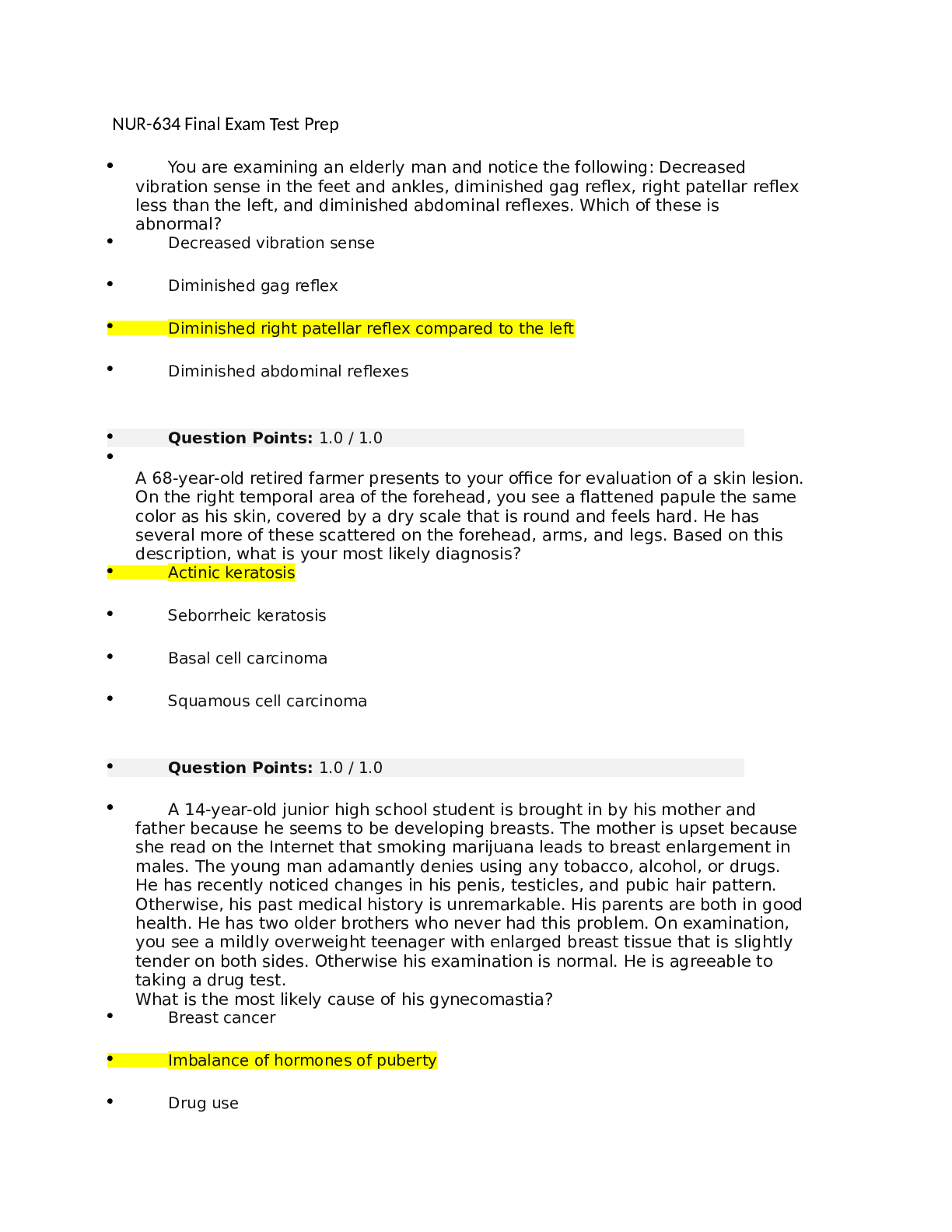
Reviews( 0 )
Document information
Connected school, study & course
About the document
Uploaded On
Aug 25, 2020
Number of pages
33
Written in
Additional information
This document has been written for:
Uploaded
Aug 25, 2020
Downloads
0
Views
52



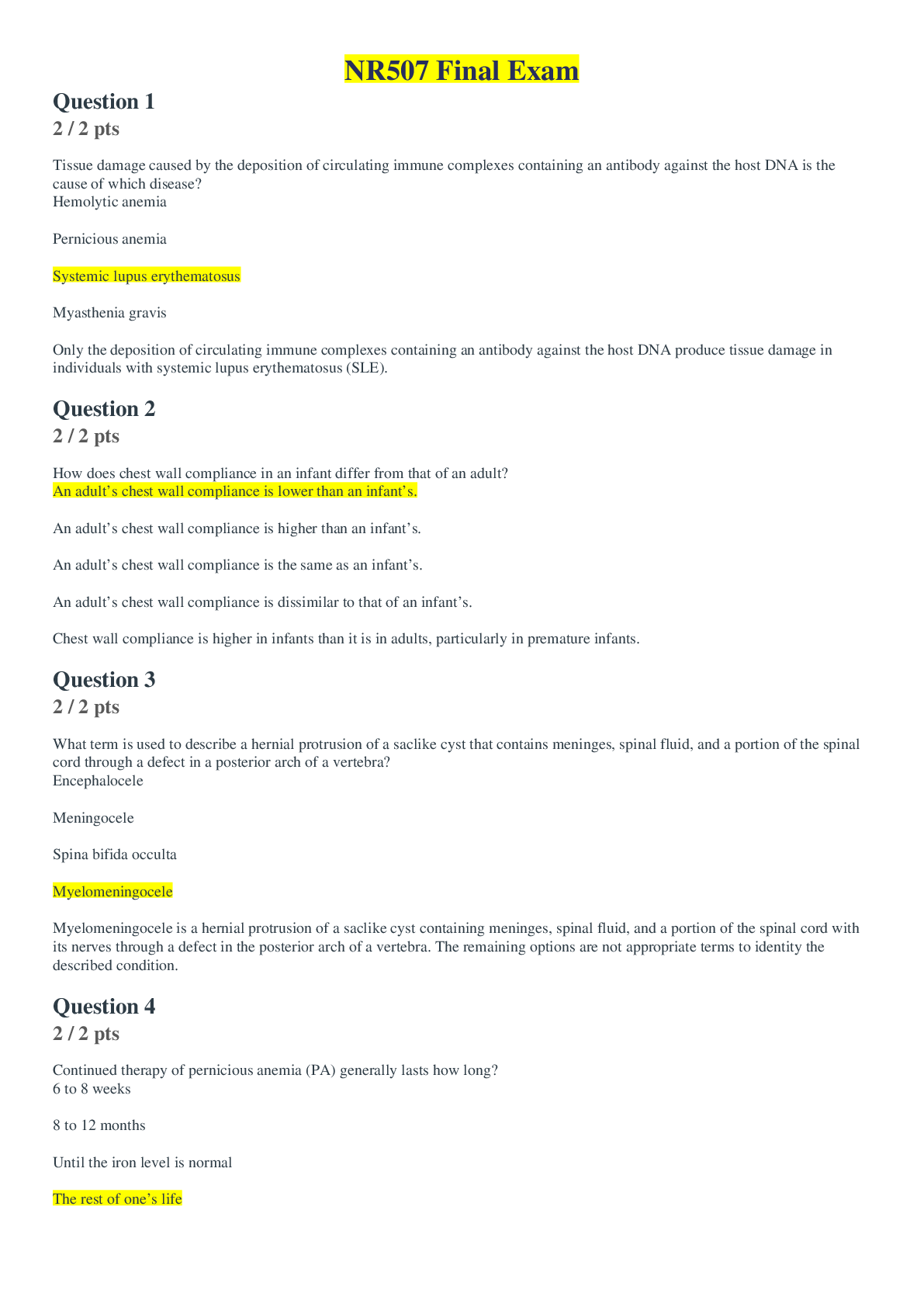

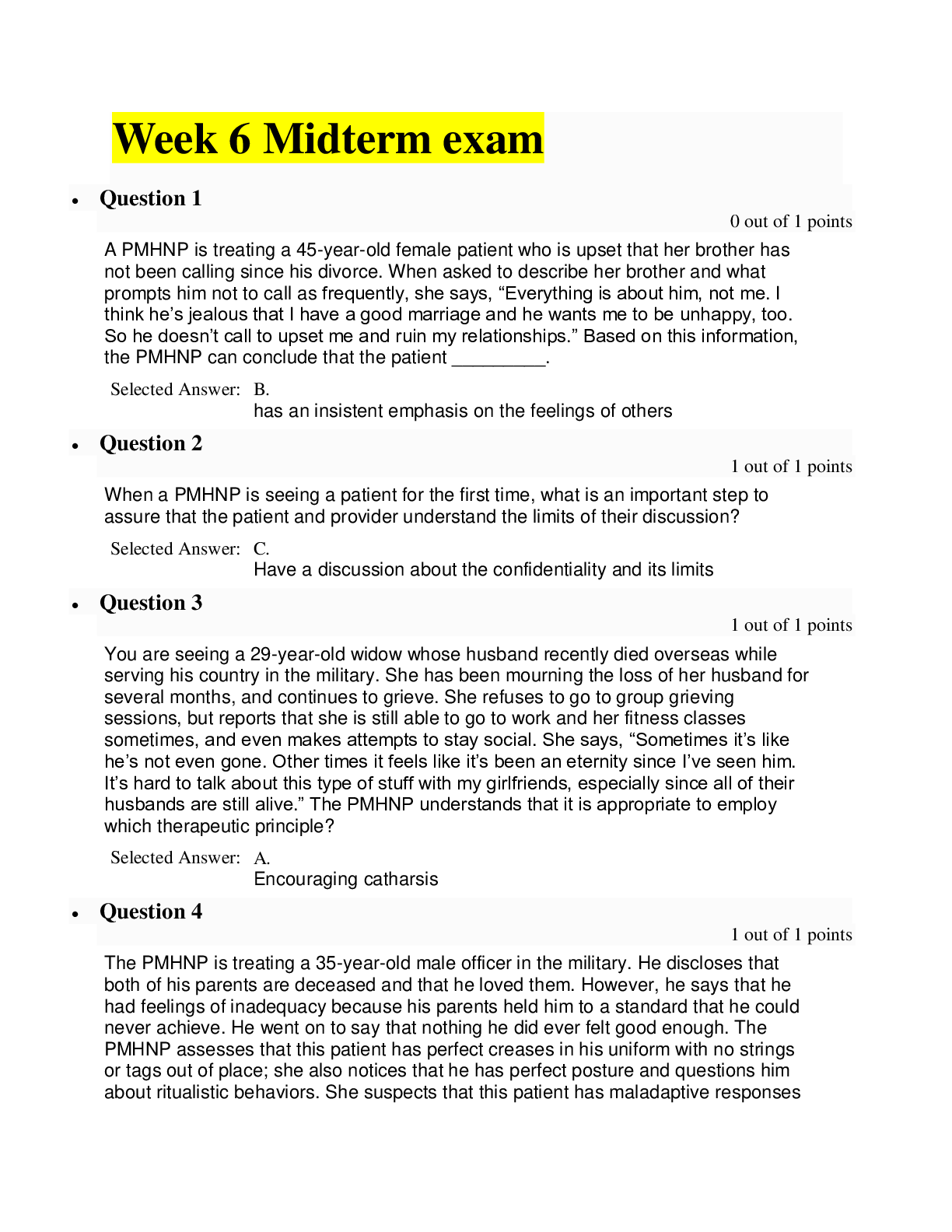

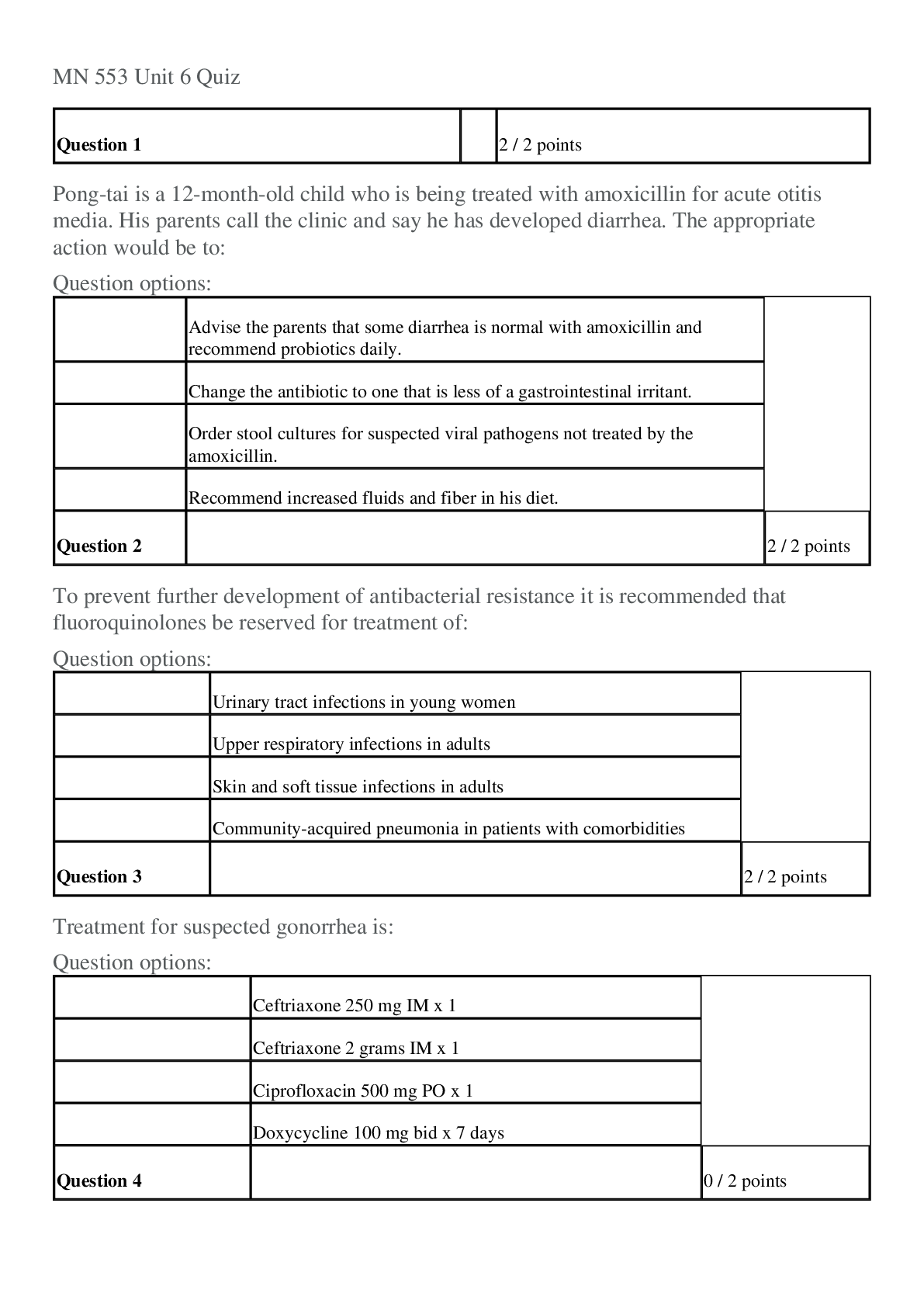


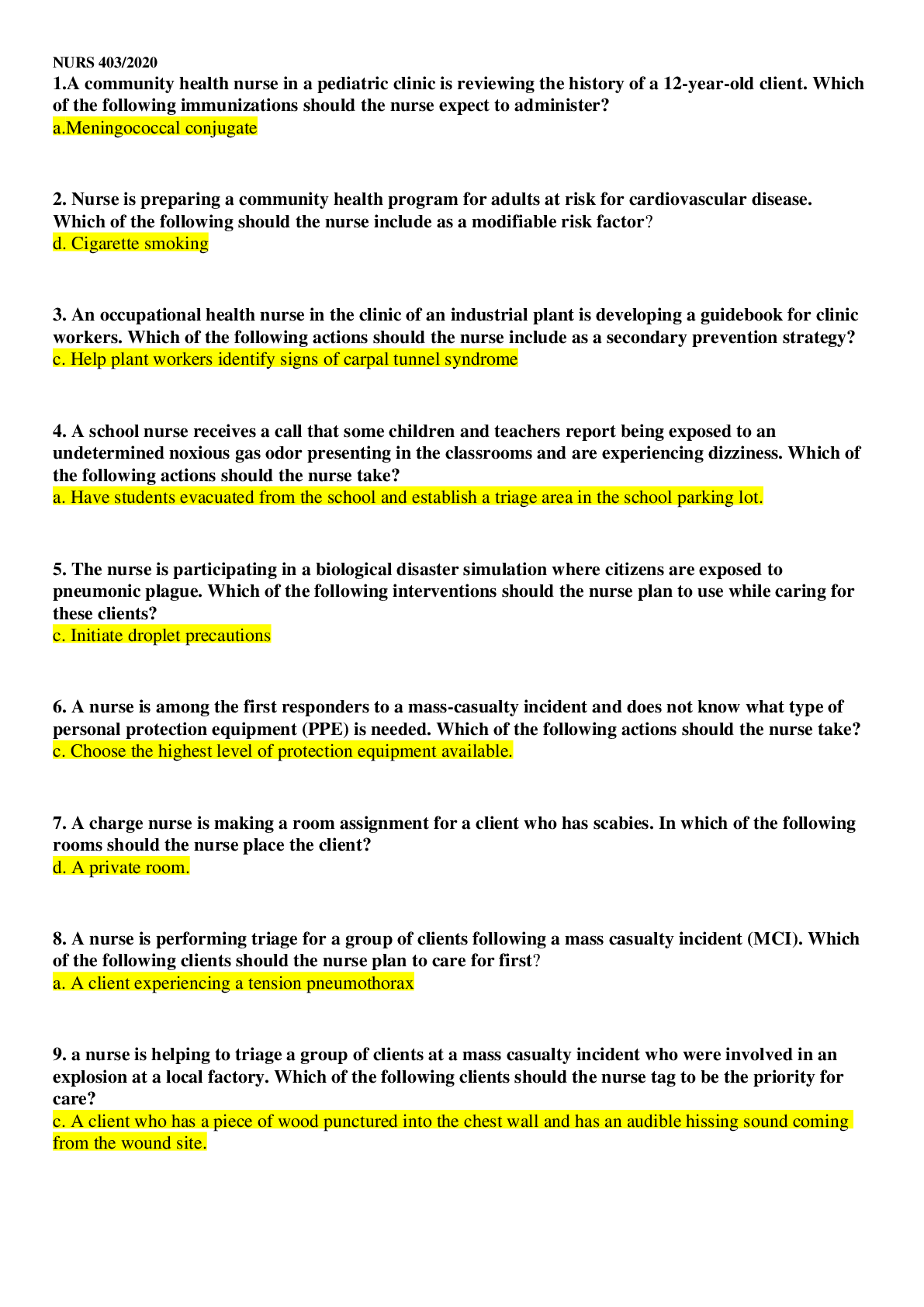

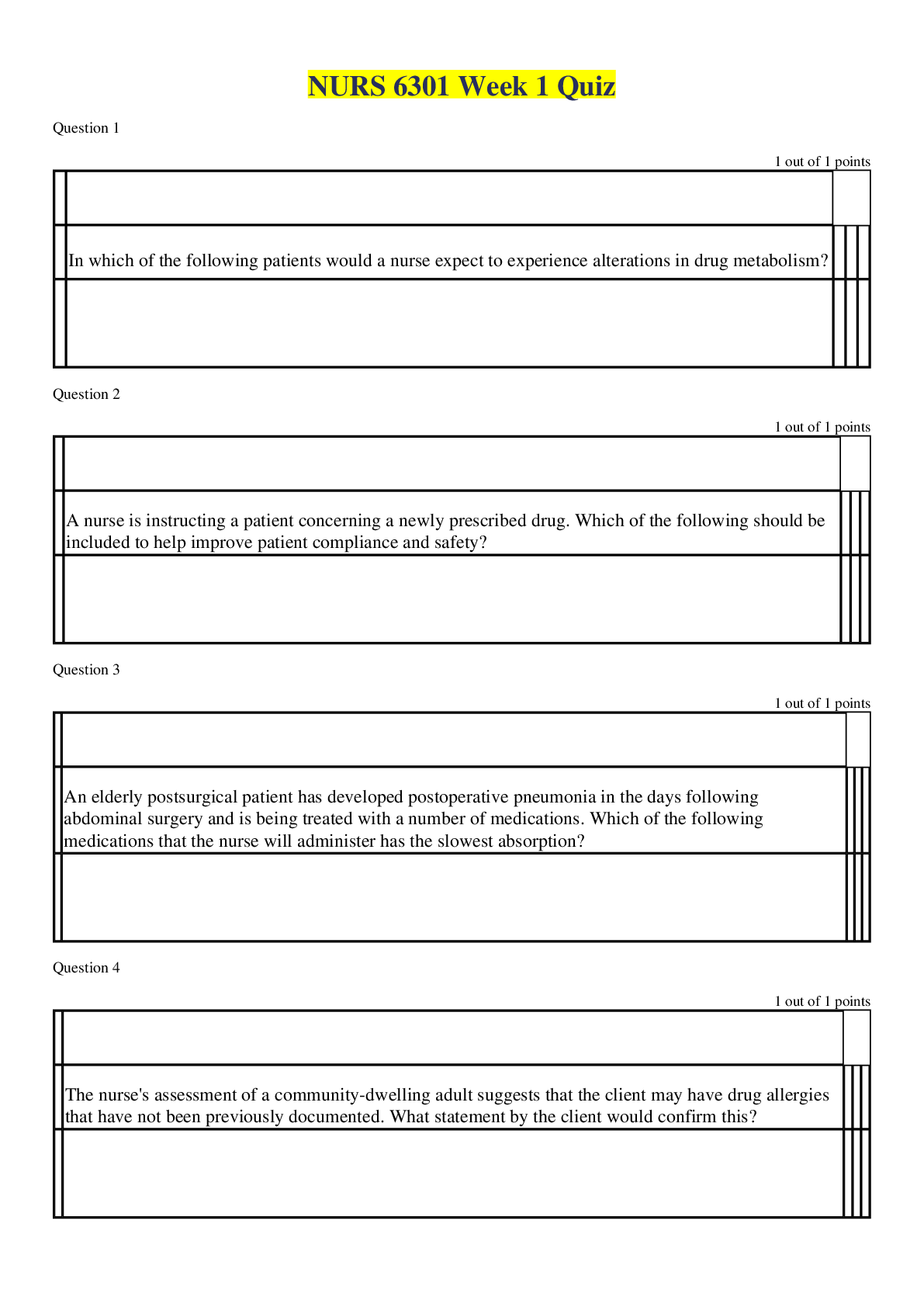
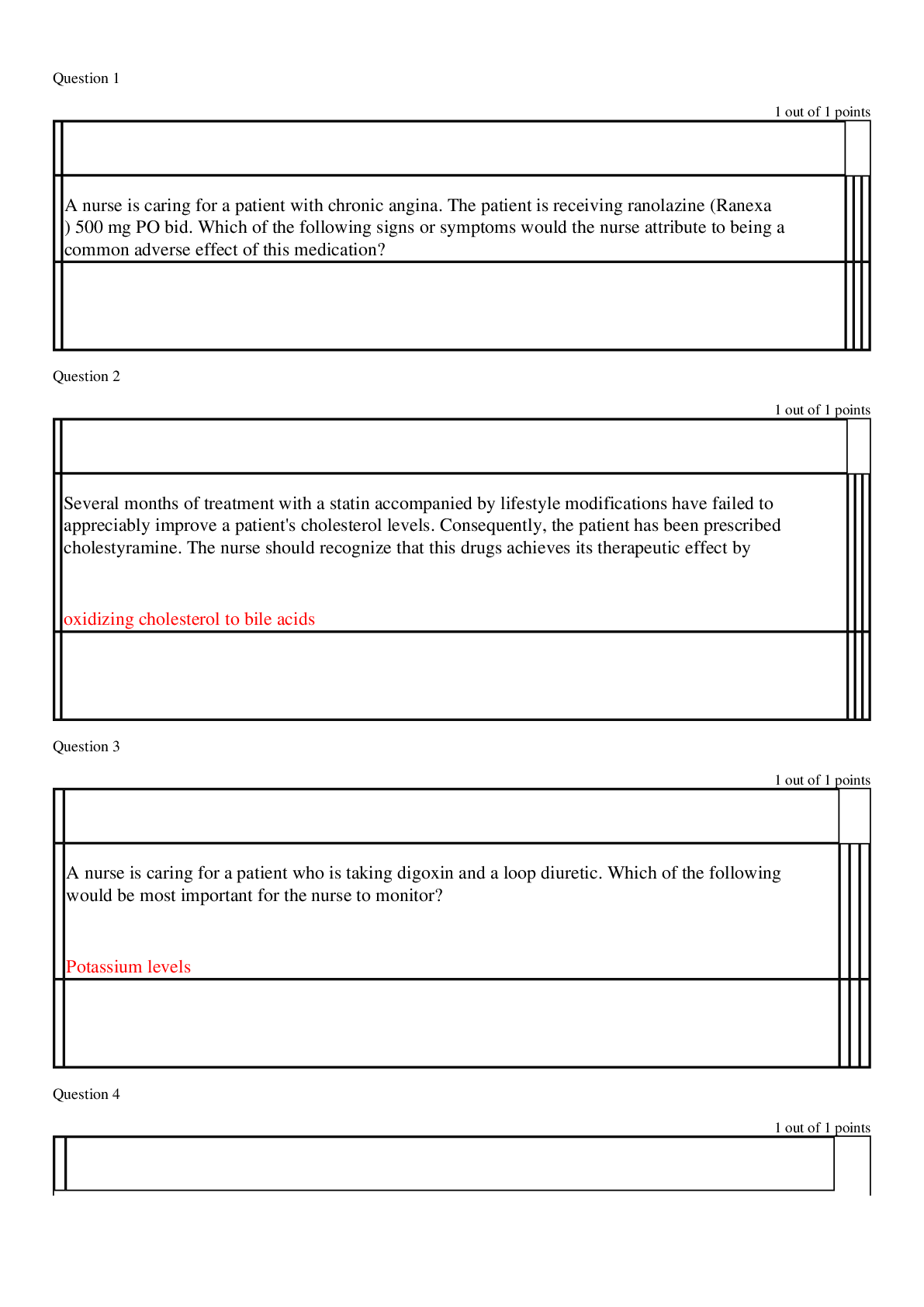

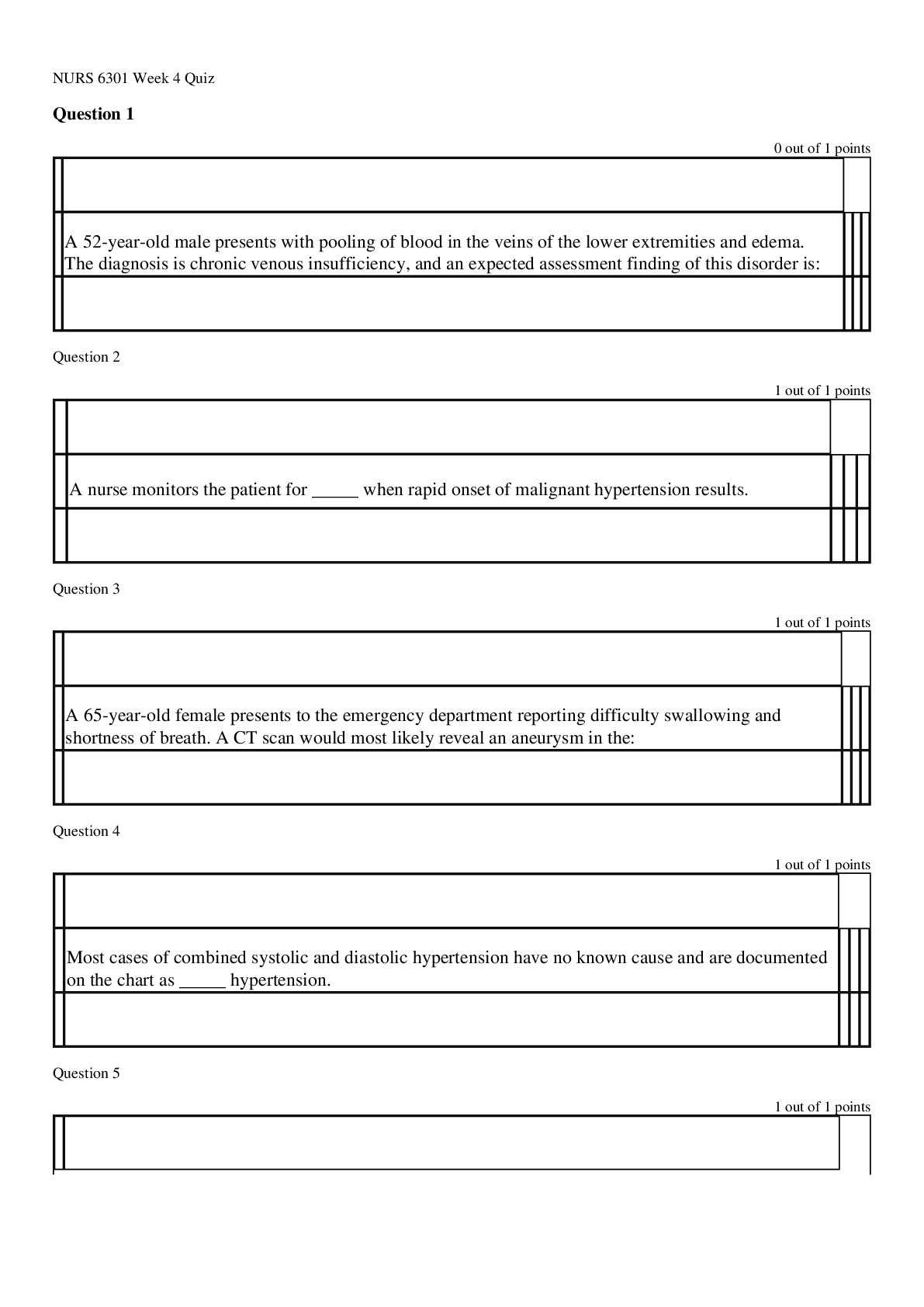
.png)

